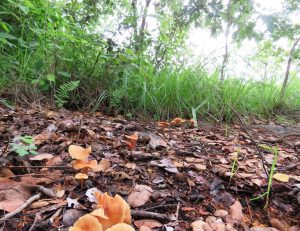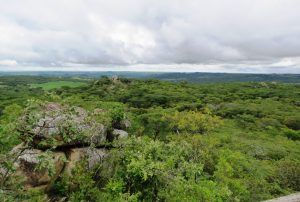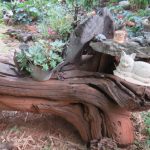TREE LIFE
February 2022

Ideal mushroom country. Photo: Rob Jarvis
Welcome to this Miombo Edition of the Tree Life Newsletter. We recently had our eyes and minds well and truly opened, firstly a visit to Heather Pocock’s beautiful property out at Goromonzi and then a week or two later we joined the famous Cathy Sharp on one of her introductory courses on macro-fungi identification. This time being held at Jabulani Safari Camp at Shangani. Both fungal and miombo hotspots.
The symbiosis between the fungi and the typical trees, under-storey vegetation and rich leaf, twig, pod mulch carpets that lie on the ground of miombo woodlands are truly special. In fact specialist fungi hunters consider our miombo woodlands to be amongst the richest fungal biodiversity environments in the World! So enjoy this ramble through some miombo moments at this special time of the year when rain brings everything to life!
Enjoy! Mafungi
Miombo Edition of the Tree Life Newsletter

The picture above depicts part of a miombo woodland in good-heart as an amiable farmer would describe healthy soil. Photo: Rob Jarvis
Hi Everyone, The picture above depicts part of a miombo woodland in good-heart as an amiable farmer would describe healthy soil. The mulch is there comprising fallen leaves, twigs and branches, if you scrape away the top layers you could find beautifully decomposed compost just millimetres below the dry leaves on top. With moisture and warmth, the fungi spring up all over the place, some feeding on the decaying vegetation, others tapping into the underground roots of the trees, but operating as symbiotic partners, feeding the tree with nutrients in exchange for fungi-digestible carbohydrates. You tamper with this natural micro-biome at your peril if you want to preserve the healthy growth of the trees and shrubs in a miombo woodland. Of course this is what all too many of us do when we have a plot, that after building upon, we now want to landscape and position flower beds and lawns around the musasa or munondo trees that we cleverly preserved with our building operations. A green year-round watered lawn is not how these miombo woodlands evolved over millions of years. They have built into their genetics the ability to grow and thrive when the short rainy season is in progress and then to shed leaves and other dead material to litter the woodland floor so that all the fungi and other micro-flora and fauna can thrive once the next rainy season comes along.

In this case, the fungus is attacking a mukwa, Pterocarpus angolensis found on the manicured green lawn of Jabulani Safaris at Shangani. Photo: Rob Jarvis
If the balance is upset, then the chances are you will start to see the appearance of fungi that notoriously feed off the woody parts of dead or dying trees and on the left we see the growth of the varnished bracket fungus, Ganoderma lucidum, which starts off as a parasite, feeding off the wood of a stressed tree and later the fungus will proliferate and grow on the dead wood of the doomed tree. In this case, the fungus is attacking a mukwa, Pterocarpus angolensis found on the manicured green lawn of Jabulani Safaris at Shangani.
I guess we all need to learn to leave the leaves and other material shed by a tree right up to the outer drip-line of the trees and only have the lawn or flower beds outside that tree-perimeter. Water the trees or the area under them at your peril.

The granite areas of Zimbabwe are one of the typical habitats of the miombo woodlands. Photo: Rob Jarvis
The granite areas of Zimbabwe are one of the typical habitats of the miombo woodlands. Here we look down the river valleys that fall away from the watershed followed by the Harare/Mutare highway. So generally we would find the flatter areas and gentler hill slopes dominated by one of the major species, Brachystegia spiciformis (musasa), Julbernardia globiflora (munondo), Brachystegia boehmii (mufuti) and on the rocky ridges Brachystegia tamarindoides (mountain brachystegia) is king. Many, many other kinds of trees and shrubs occur in and amongst these stalwarts of the Zimbabwean countryside and our outings to Goromonzi and Shangani reinforced this. Acacias abound, as do Piliostigma, Syzygium, Uapaca, Terminalia and many, many others.
Around the boulder-strewn summits of the kopjes can be found dense copses of Maytenus with their fine shiny leaves. They seem to thrive in the rich earthy soil that accumulates from a combination of leaf litter and dassie dung. There will be moss everywhere and the shady thickets will make excellent resting places for old, tired bones when on a tree-hunting ramble. Pray, do not tarry in such places for too long, because these areas are home to deadly predators too, like the black mamba, leopards and the like.

But everywhere you look, the trees are complimented by the fungi. Working together to keep the system going.
Photo: Rob Jarvis

There will be moss everywhere and the shady thickets will make excellent resting places for old, tired bones when on a tree-hunting ramble. Photo: Rob Jarvis

Here we see brightly ornamented larvae of a moth literally eating every leaf on a protea at Goromonzi. Photo: Rob Jarvis
Lush growing vegetation full of nutrients, carbohydrates and protein inevitably becomes a target for voracious pests. Here we see brightly ornamented larvae of a moth literally eating every leaf on a protea at Goromonzi. With no leaves, flowers and other parts, tree identification can be very difficult! In nature it is usually rare to see total destruction of the plant material by pests. We all know in farming and in our gardens that there are certain pests that can come and eat every aerial part of Crinum lilies for instance. But out there in the wild green yonder, Nature usually ensures a balance and pests are usually controlled by some naturally occurring predator or disease that allows all living things to amble along without total destruction. On this subject we all know that dung beetles play a vital role in recycling both wild animal and domesticated livestock dung. Where the beetle populations are high they congregate in vast numbers and tumble their dung balls along and dig them deep into the soil for the larvae to feed off and emerge a short while later as fully mature beetles to continue the cycle.

However at both Goromonzi and Jabulani at Shangani they were much in evidence. Photo: Rob Jarvis
Of concern to me where I work, on an intensive agricultural model farm, right on the peri-urban edge of Harare, we hardly see dung beetles in action. Unfortunately we use too many highly toxic dips and innoculations and dosings to keep the parasitic predators of cattle, pigs and sheep at bay. However at both Goromonzi and Jabulani at Shangani they were much in evidence and the outdoor lights were buzzing with the beasts attracted to the night-lights. After their work on the dung, all you see is a an area of disturbed soil on the surface.
And their work clearly is beneficial to the trees and fungi. Nutrients are rapidly removed from the soil surface and placed underground where the feeding of the larvae results in nutrients being quickly released in the root zones of the plants above. Or directly to dung fungi.
Above you can see a recently deposited cow-pat almost completely rolled-up and tidied away by these industrious insects from a solid rock monolith. Manna from Heaven indeed.

Above we see Cathy Sharp demonstrating some key points about a fungus found at Jabulani in Shangani. Photo: Rob Jarvis
On the right we see Cathy Sharp demonstrating some key points about a fungus found at Jabulani in Shangani. It was really fascinating to learn a little about this very transient world of fungi, that are so vital to the healthy functioning of almost every ecosystem and to find out just how richly blessed we are in this part of the World to have the miombo woodlands that have the best and most of everything. We learnt to identify, to categorise, to induce spore shedding and to begin to understand how the micro-flora and fauna interact with the other plants, trees and animal, insects and birdlife of rural Zimbabwe. Cathy will be doing Fungi Walks at Mukuvisi Woodlands later this month and out at Umwinsidale so keep a look out for these and try and attend at least one. Keep your ears to the ground.

. Photo: Rob Jarvis
I have not included a Tree of the Month page this edition but rather let’s look at the miombo woodlands as our Ecosystem of the Millennium. On the left we see the almost immediate effect of rain upon the woodland floor with the musasa ferns springing up amongst the trees and granite boulders, themselves covered in the symbiotically married fungi and bacteria that constitute lichen. If we look closely on the forest floor there will be fungi, magically growing where food sources are available and in turn feeding the trees above.
The Tree Society has a webpage https://treesociety.org.zw and has a WhatsApp Group for day to day communication.
Tree huggers please feel free to utilise these services and suggest improvements or additions where appropriate.
CHAIRMAN TONY ALEGRIA



